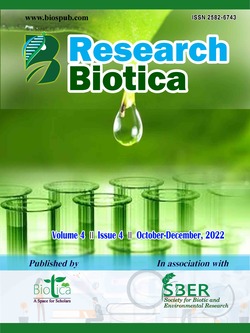
Optimal Date of Mulberry Pruning and Silkworm Rearing for Improvement of Quality and Yield Potential of Mulberry Foliage and Silk Cocoons in Lower-Gangetic Region
Suresh, K.*
Central Sericultural Research and Training Institute, Berhampore, West Bengal (742 101), India
Manjappa
Central Sericultural Research and Training Institute, Mysuru, Karnataka (570 008), India
Deepika Kumar Umesh
Central Sericultural Research and Training Institute, Berhampore, West Bengal (742 101), India
Yallappa Harijan
Central Sericultural Research and Training Institute, Berhampore, West Bengal (742 101), India
C.M. Kishor Kumar
Central Sericultural Research and Training Institute, Berhampore, West Bengal (742 101), India
DOI: https://doi.org/10.54083/ResBio/4.4.2022/185-190
Keywords: Mulberry, Pruning, Rearing, Silkworm, Weather
Abstract
Mulberry sericulture is an alternative farm-based livelihood activity and is practiced in various climatic conditions. A field and rearing experiment was conducted to evaluate the mulberry variety S-1635 for leaf and silk cocoon productivity under alternative pruning and rearing schedule during autumn 2019 and spring 2020 seasons. The leaf moisture content, leaf fall at harvest, primary shoots plant-1, longest shoot length, total shoots length and leaf yield plant-1 was significantly higher in new pruning schedule in both the season. The new mulberry crop schedule recorded higher leaf productivity to a tune of 12% in autumn and double in comparison to existing schedule practiced by farmers. The role of optimal weather and period of crop growth had a greater impact on leaf yield during autumn and spring crops, respectively. Most of the reeling cocoon and silk parameters obtained from fed leaves differed significantly with pruning schedules in both the seasons. Effective rate of rearing and weight was significantly higher in new pruning schedule while single cocoon weight was higher in existing schedule. The new silkworm rearing schedule recorded 10-12% higher cocoon yield in both Agrahayani (75.67 kg) and Falguni (62.08 kg) crops compared to existing crop schedule. The investigation revealed that delaying the mulberry pruning and silkworm rearing date by two weeks effectively increased both leaf and cocoon output. The new mulberry sericulture crop schedules will be a climate change adaptation strategy to maintain production potential in the lower-gangetic region.
Downloads
not found
Reference
Anonymous, 2022. Annual Report 2021-22. Central Silk Board, Ministry of Textiles Government of India, Central silk board publications, Bengaluru, India. pp. 84-85. URL: https://csb.gov.in/publications/annual-report/.
Boschini, C.F., 1995. Establishment and management of mulberry for intensive forage production. In: Mulberry for Animal Production. (Ed.) Sánchez, M.D. Food and Agriculture Organization of the United Nations, Rome. pp. 115-122. URL: https://www.fao.org/3/X9895E/x9895e09.htm.
Chatterjee, M., Ray, N., 2020. Studies on rearing performances of mulberry silkworm (Bombyx mori) in Hooghly district of West Bengal (India): A newly explored area. Acta Fytotechnica et Zootechnica 23(2), 85-93. DOI: https://doi.org/10.15414/afz.2020.23.02.85-93.
Dandin, S.B., Jayswal, J., Giridhar, K., 2003. Hand Book of Sericulture Technologies. Central Silk Board Publications, Bengaluru, India. pp. 210-230.
Dandin, S.B. and Giridhar, K., 2010. Hand Book of Sericulture Technologies. Central Silk Board Publications, Bengaluru, India. pp. 10-11.
Datta, R.K., 2000. Mulberry cultivation and utilization in India. In: Mulberry for Animal Production. (Ed.) Sánchez, M.D. Food and Agriculture Organization of the United Nations, Rome. pp. 45-62. URL: https://www.fao.org/3/x9895E/x9895e04.htm.
Miyashitha, V., 1986. A Report on Mulberry and Training Methods Suitable to Bivoltine Rearing in Karnataka. Central Silk Board Publications, Bengaluru, India. pp. 1-7.
Nagarajan, P., Radha, N.V., 1990. Supplementation of amino acids through mulberry leaf for increased silk production. Indian Silk 29(4), 21-22.
Neelaboina, B.K., Khan, G.A., Kumar, S., Gani, M., Ahmad, M.N., Ghosh, M.K., 2018. Impact of climate change on agriculture and sericulture. Journal of Entomology and Zoology Studies 6(5), 426-429.
Pawan, Sharma, J.R., Satpal, B., Singh, S., Kumar, M., 2017. Effect of the time and severity of pruning on growth, yield and quality in mulberry (Morus alba L.). International Journal of Agriculture Sciences 9(50), 4861-4863.
Rajan, R.K., Himantharaj, M.T., 2005. A Text Book on Silkworm Rearing Technology. Central Silk Board Publications, Bengaluru, India. pp. 28-31.
Sarkar, K., 2018. Management of nutritional and climatic factors for silkworm rearing in West Bengal: A review. International Journal of Agriculture Environment and Biotechnology 11(5), 769-780. DOI: https://doi.org/10.30954/0974-1712.10.2018.9.
Shah, H., Siderius, C., Hellegers, P., 2021. Limitations to adjusting growing periods in different agroecological zones of Pakistan. Agricultural Systems 192, 1-15. DOI: https://doi.org/10.1016/j.agsy.2021.103184.
